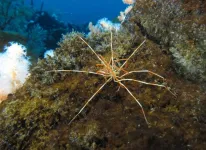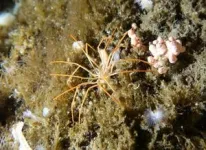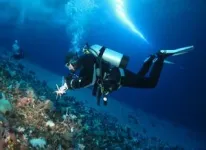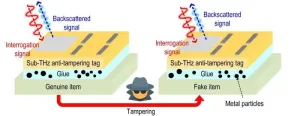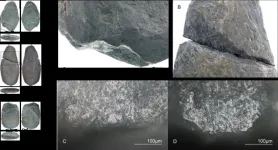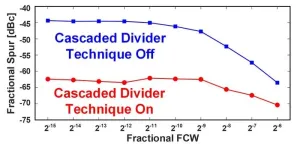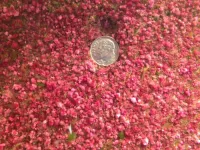(Press-News.org) Link to video and sound (details below): https://spaces.hightail.com/receive/JwM0o5gQdq
The reproduction of giant sea spiders in Antarctica has been largely unknown to researchers for more than 140 years, until now. University of Hawaiʻi at Mānoa scientists traveled to the remote continent and saw first-hand the behaviors of these mysterious creatures, and their findings could have wider implications for marine life and ocean ecosystems in Antarctica and around the world.
Sea spiders, or pycnogonids, are a group of spider-like invertebrates found in marine habitats globally. Most species are smaller than a fingernail, but some Antarctic species have leg spans (tip of one leg to the tip of the opposite leg) of more than a foot. These animals are a famous example of “polar gigantism,” a phenomenon where certain organisms in polar regions, such as the Arctic and Antarctic, grow to much larger sizes than their relatives in warmer climates.
“In most sea spiders, the male parent takes care of the babies by carrying them around while they develop,” UH Mānoa School of Life Sciences Professor and lead researcher Amy Moran said. “What’s weird is that despite descriptions and research going back over 140 years, no one had ever seen the giant Antarctic sea spiders brooding their young or knew anything about their development.”
Moran’s lab has studied polar gigantism for more than a decade. In October 2021, during a field research expedition to Antarctica, the team, including Moran and School of Life Sciences PhD students Aaron Toh and Graham Lobert, made a groundbreaking discovery. Diving under the ice, they hand-collected groups of giant sea spiders that appeared to be mating and transported them to tanks for observation.
To their amazement, two different mating groups produced thousands of tiny eggs. Instead of carrying the babies until they hatched, as in most species of sea spiders, one parent (likely the father) spent two days attaching the eggs to the rocky bottom where they developed for several months before hatching as tiny larvae. The researchers findings were published in Ecology in February 2024.
“We were so lucky to be able to see this,” Toh said. “The opportunity to work directly with these amazing animals in Antarctica meant we could learn things no one had ever even guessed.”
Within weeks after laying, the eggs had been overgrown with microscopic algae, providing perfect camouflage.
“We could hardly see the eggs even when we knew they were there, which is probably why researchers had never seen this before,” Lobert said.
Breakthrough research
Lloyd Peck, a renowned Antarctic biologist with the British Antarctic Survey who was not involved with the study said, “The general ecology and reproductive biology of Antarctic marine species remains overwhelmingly unknown and we have data on only a handful of species, so papers like this one are of huge importance in shedding light on how animals function in one of the least studied parts of the world’s ocean.”
The UH Mānoa School of Life Sciences is housed in the College of Natural Sciences.
Link to video and sound (details below): https://spaces.hightail.com/receive/JwM0o5gQdq
VIDEO:
BROLL: (0:55)
0:00-0:05: Up close look at the Antarctic sea spider
0:05-0:39: UH researchers diving to collect the sea spiders
0:40-0:45: UH researchers jumping into the icy cold waters
0:45-0:55: UH researchers flying into McMurdo Station in Antarctica
SOUNDBITES:
Amy Moran, UH Mānoa School of Life Sciences professor
(14 seconds)
“These giant sea spiders, the males do care for the young, but they do it differently and they do it in a much simpler way than the other sea spiders. So it may provide a kind of a look at the evolutionary bridge that leads to fathers taking care of their offspring.”
Graham Lobert, UH Mānoa School of Life Sciences PhD candidate
(13 seconds)
“So the organisms and the ecosystems that are down there are very difficult to study and to be able to find something that's, has been, eluded researchers for 140 plus years is really amazing.”
END
Giant Antarctic sea spiders reproductive mystery solved by UH researchers
2024-02-18
ELSE PRESS RELEASES FROM THIS DATE:
This tiny, tamper-proof ID tag can authenticate almost anything
2024-02-18
A few years ago, MIT researchers invented a cryptographic ID tag that is several times smaller and significantly cheaper than the traditional radio frequency tags (RFIDs) that are often affixed to products to verify their authenticity.
This tiny tag, which offers improved security over RFIDs, utilizes terahertz waves, which are smaller and travel much faster than radio waves. But this terahertz tag shared a major security vulnerability with traditional RFIDs: A counterfeiter could peel the tag off a genuine item and reattach it to a fake, and the authentication system would be none the wiser.
The researchers have now surmounted ...
Viruses that can help ‘dial up’ carbon capture in the sea
2024-02-17
DENVER – Armed with a catalog of hundreds of thousands of DNA and RNA virus species in the world’s oceans, scientists are now zeroing in on the viruses most likely to combat climate change by helping trap carbon dioxide in seawater or, using similar techniques, different viruses that may prevent methane’s escape from thawing Arctic soil.
By combining genomic sequencing data with artificial intelligence analysis, researchers have identified ocean-based viruses and assessed their genomes to find that they “steal” genes from other microbes or cells that process carbon in the sea. Mapping microbial ...
Imageomics poised to enable new understanding of life
2024-02-17
Embargoed until 1:30 p.m. ET, Saturday Feb. 17, 2024
DENVER – Imageomics, a new field of science, has made stunning progress in the past year and is on the verge of major discoveries about life on Earth, according to one of the founders of the discipline.
Tanya Berger-Wolf, faculty director of the Translational Data Analytics Institute at The Ohio State University, outlined the state of imageomics in a presentation on Feb. 17, 2024, at the annual meeting of the American Association for the Advancement of Science.
“Imageomics ...
Scientists try out stone age tools to understand how they were used
2024-02-17
Tokyo, Japan – Researchers from Tokyo Metropolitan University crafted replica stone age tools and used them for a range of tasks to see how different activities create traces on the edge. They found that a combination of macroscopic and microscopic traces can tell us how stone edges were used. Their criteria help separate tools used for wood-felling from other activities. Dated stone edges may be used to identify when timber use began for early humans.
For prehistoric humans, improvements in woodworking technology were revolutionary. While Paleolithic (early stone age) artifacts point to the use of wood for simple tools such as spears ...
Combating fractional spurs in phase locked loops to improve wireless system performance in Beyond 5G
2024-02-17
Two innovative design techniques lead to substantial improvements in performance in fractional-N phase locked loops (PLLs), report scientists from Tokyo Tech. The proposed methods are aimed to minimize unwanted signals known as fractional spurs, which typically plague PLLs used in many modern radar systems and wireless transceivers. These efforts could open doors to technological improvements in wireless communication, autonomous vehicles, surveillance, and tracking systems in beyond 5G era.
Many emerging and evolving technologies, such as self-driving vehicles, target tracking systems, and remote sensors, rely on the high-speed and error-free operation ...
20th Annual National Jewish Health Respiratory Disease Young Investigators’ Forum calls for abstracts
2024-02-17
DENVER — Young physician investigators interested in research careers in pulmonology, allergy and immunology, pediatric and related programs, are encouraged to submit basic science or clinical research abstracts by June 3, 2024, to be considered for participation in the 20th Annual Respiratory Disease Young Investigators’ Forum. This year’s Forum will take place October 17-20, 2024, in Denver.
The annual event provides career development and research opportunities for fellows and early career faculty. The Forum is a celebration of talent and ingenuity in respiratory medicine. Physician-scientists in fellowship ...
Study highlights importance of genetic sequencing to diagnosis of growth disorders
2024-02-16
In an article published in the Journal of Pediatrics, researchers based in Brazil describe the case of a nine-year-old boy admitted to hospital with multiple symptoms and overlapping conditions that made diagnosis difficult, such as short stature, thin tooth enamel (dental enamel hypoplasia), moderate mental deficiency, speech delay, asthma, mildly altered blood sugar, and a history of recurring infections in infancy.
The team used exome sequencing, in which only the protein-coding portion of the genome is analyzed, to look for genetic mutations, and found them in GCK and BCL11B. ...
Sylvester appoints prominent oncologist-researcher to lead transplantation and cellular therapy
2024-02-16
MIAMI, FLORIDA (Feb. 15, 2024) – Prominent oncologist and researcher Damian Green, M.D., will join Sylvester Comprehensive Cancer Center at the University Miami Miller School of Medicine this spring to lead its transplantation and cellular therapy services.
Green will serve as chief of Sylvester’s Division of Transplantation & Cellular Therapy, as well as assistant director of Translational Research, beginning March 1. He joins Sylvester from Fred Hutchinson Cancer Center in Seattle, where he built a distinguished track record in research and ...
Without social distancing, how do bacteria survive a viral epidemic?
2024-02-16
By Wynne Parry
WOODS HOLE, Mass. – Like humans struggling to get through the COVID-19 pandemic, bacterial cells need social distancing to thwart viruses. But in some situations, such as inside elevators or within the candy-colored bacterial structures known as “pink berries,” staying apart just isn’t feasible.
Looking like spilled Nerds or Pop Rocks, the communal, multicellular pink berries litter the submerged surface of salt marshes in and around Woods Hole. New research conducted at the Marine Biological ...
Commercial AI tool moderately successful at predicting hospitalization-related kidney injury
2024-02-16
Hospital-acquired acute kidney injury (HA-AKI) is a common complication in hospitalized patients that can lead to chronic kidney disease and is associated with longer hospital stays, higher health care costs and increased mortality. Given these negative consequences, preventing HA-AKI can improve hospitalized patient outcomes. However, anticipating HA-AKI onset is difficult due to a large number of contributing factors involved.
Researchers from Mass General Brigham Digital tested a commercial machine learning tool, the Epic Risk of HA-AKI predictive model, and found it was moderately successful at predicting risk of HA-AKI in recorded patient data. ...
